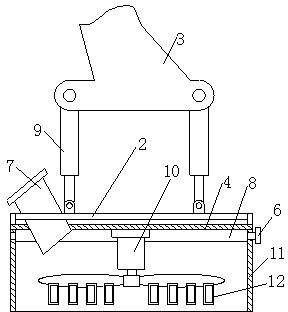River/lake heavy metal pollution sediment in-situ coverage method and device
A technology for polluting sediment and covering devices, which is applied in sludge treatment, chemical instruments and methods, water/sludge/sewage treatment, etc., to reduce adverse effects, avoid effective volume reduction, and prevent resuspension.
- Summary
- Abstract
- Description
- Claims
- Application Information
AI Technical Summary
Problems solved by technology
Method used
Image
Examples
Embodiment Construction
[0021] figure 1 and figure 2 The structure of the in-situ covering device for heavy metal contaminated sediment in rivers and lakes of the present invention is given. The device includes at least two covering units 1, each covering unit 1 is connected in series, and the adjacent covering units 1 are connected by a connecting frame 2. Together. The connecting frame 2 is connected with the landing gear 3 through the hydraulic cylinder 9, the piston rod of the hydraulic cylinder 9 is hinged with the connecting frame 2, the cylinder body of the hydraulic cylinder 9 is hinged with the landing gear 3, and the number of the hydraulic cylinders 9 can be determined according to the volume of the covering unit 1 , and its power can ensure that the covering unit 1 extends into the bottom mud polluted by heavy metals and can be pulled out. During specific use, the landing gear 3 is fixed on the shore or the moving hull, and the covering unit 1 is stretched into or pulled out from the b...
PUM
| Property | Measurement | Unit |
|---|---|---|
| particle diameter | aaaaa | aaaaa |
Abstract
Description
Claims
Application Information
 Login to View More
Login to View More - R&D
- Intellectual Property
- Life Sciences
- Materials
- Tech Scout
- Unparalleled Data Quality
- Higher Quality Content
- 60% Fewer Hallucinations
Browse by: Latest US Patents, China's latest patents, Technical Efficacy Thesaurus, Application Domain, Technology Topic, Popular Technical Reports.
© 2025 PatSnap. All rights reserved.Legal|Privacy policy|Modern Slavery Act Transparency Statement|Sitemap|About US| Contact US: help@patsnap.com


